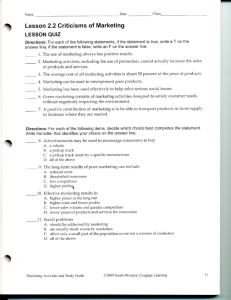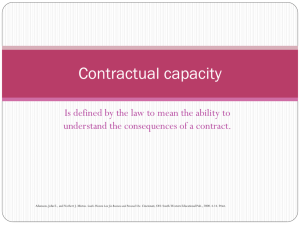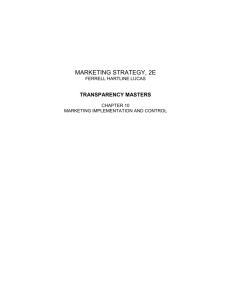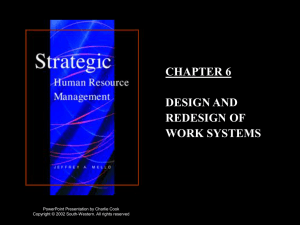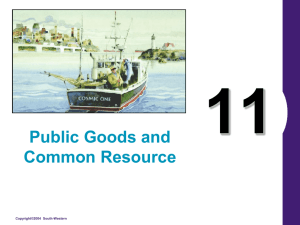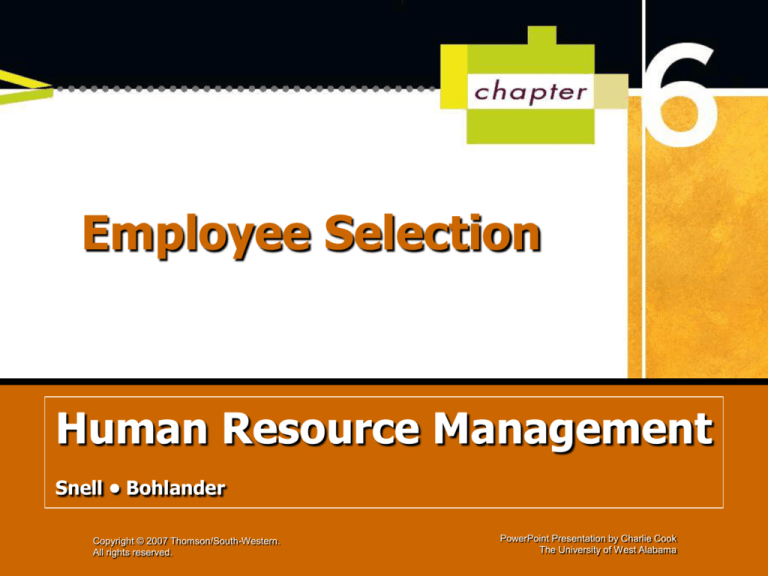
Employee Selection
Human
Resource
Management
Managing Human Resources
• Snell
SnellBohlander
• Bohlander
Copyright © 2007 Thomson/South-Western.
All rights reserved.
14th edition
PowerPoint Presentation by Charlie Cook
The University of West Alabama
Objectives
After studying this chapter, you should be able to:
1. Explain the objectives of the personnel selection
process.
2. Identify the various sources of information used for
personnel selection.
3. Compare the value of different types of
employment tests.
4. Illustrate the different approaches to conducting an
employment interview.
5. Describe the various decision strategies for
selection.
Copyright © 2007 South-Western. All rights reserved.
6–2
Matching People and Jobs
• Selection
The process of choosing individuals who have
relevant qualifications to fill existing or projected job
openings.
• Selection Considerations
Person-job fit: job analysis identifies required
individual competencies (KSAOs) for job success.
Person-organization fit: the degree to which
individuals are matched to the culture and values of
the organization.
Copyright © 2007 South-Western. All rights reserved.
6–3
Figure 6–1
The Goal of Selection: Maximize “Hits”
Copyright © 2007 South-Western. All rights reserved.
6–4
Figure 6–2
Steps in the Selection Process
Hiring decision
Medical exam/drug test
Supervisor/team interview
Preliminary selection in
HR department
Background investigation
Employment testing
(aptitude, achievement)
Initial interview in
HR department
Completion of application
Copyright © 2007 South-Western. All rights reserved.
Note: Steps may vary. An
applicant may be rejected
after any step in the process.
6–5
The Selection Process
• Obtaining Reliable and Valid Information
Reliability
The degree to which interviews, tests, and other
selection procedures yield comparable data over time
and alternative measures.
Validity
Degree to which a test or selection procedure measures
a person’s attributes.
Copyright © 2007 South-Western. All rights reserved.
6–6
Reliability as Stability over Time
HIGH RELIABILITY
APPLICANT
Smith
Perez
Riley
Chan
TEST
SCORE
90
65
110
80
RETEST
SCORE
93
62
105
78
VERY LOW RELIABILITY
APPLICANT
Smith
Perez
Riley
Chan
TEST
SCORE
90
65
110
80
RETEST
SCORE
72
88
67
111
Copyright © 2007 South-Western. All rights reserved.
6–7
Reliability as Consistency
(Interrater Reliability)
HIGH RELIABILITY
APPLICANT
Smith
Perez
Riley
Chan
Rater #1
9
5
4
8
Rater #2
8
6
5
8
Rater #3
8
5
5
8
VERY LOW RELIABILITY
APPLICANT
Smith
Perez
Riley
Chan
Rater #1
9
5
4
8
Copyright © 2007 South-Western. All rights reserved.
Rater #2
5
9
2
4
Rater #3
6
4
7
2
6–8
Valid and Invalid Tests
Copyright © 2007 South-Western. All rights reserved.
6–9
Approaches to Validation
• Criterion-related Validity
The extent to which a selection tool predicts, or
significantly correlates with, important elements of
work behavior.
A high score indicates high job performance potential; a
low score is predictive of low job performance.
• Concurrent Validity
The extent to which test scores (or other predictor
information) match criterion data obtained at about
the same time from current employees.
High or low test scores for employees match their
respective job performance.
Copyright © 2007 South-Western. All rights reserved.
6–10
Approaches to Validation (cont’d)
• Predictive Validity
The extent to which applicants’ test scores match
criterion data obtained from those applicants/
employees after they have been on the job for some
indefinite period.
A high or low test score at hiring predicts high or low job
performance at a point in time after hiring.
• Validity (or Correlation) Coefficient
A number ranging from 0.00, denoting a complete
absence of relationship, to 1.00 and to -1.00,
indicating a perfect positive and perfect negative
relationship, respectively.
Copyright © 2007 South-Western. All rights reserved.
6–11
Figure 6–3
Correlation Scatterplots
Copyright © 2007 South-Western. All rights reserved.
6–12
Approaches to Validation
• Cross-validation
Verifying the results obtained from a validation study
by administering a test or test battery to a different
sample (drawn from the same population).
• Validity generalization
The extent to which validity coefficients can be
generalized across situations.
Copyright © 2007 South-Western. All rights reserved.
6–13
Approaches to Validation (cont’d)
• Content validity
The extent to which a selection instrument, such as a
test, adequately samples the knowledge and skills
needed to perform a particular job.
Example: typing tests, driver’s license examinations
• Construct validity
The extent to which a selection tool measures a
theoretical construct or trait.
Are difficult to validate
Example: creative arts tests, honesty tests
Copyright © 2007 South-Western. All rights reserved.
6–14
Steps in Validating a Test (Criterion-Related Validity)
Examination of the job
Job analysis/specifications
Selection of criteria
Collect criterion data
(concurrent method)
OR
Alternative/
optional
Selection of tests
for tryout
Collect criterion data
(predictive method)
Administer tests
Relate test scores to criterion data,
then cross validate
Plan research for test
(continuing cross validation)
Interpret results for operational
use of tests
Include test(s) in selection
process (operational)
Analyze follow-up data
Copyright © 2007 South-Western. All rights reserved.
Revise operational program
6–15
Sources of Information about Job
Candidates
• Application Forms
• Online Applications
• Biographical Information
Blanks (BIB)
• Background
Investigations
• Integrity and Honesty
Tests
• Graphology
• Medical Examinations
• Employment Tests
• Interviews
• Polygraph Tests
Copyright © 2007 South-Western. All rights reserved.
6–16
Figure 6–4
The Effectiveness of Selection Methods
In a survey of 201 HR executives, participants were asked which
selection methods produce the best employees. The mean rating for
nine methods on a 5-point scale (1 = not good, 3 = average,
5 = extremely good):
Work samples
3.68
References/recommendations
3.49
Unstructured interviews
3.49
Structured interviews
3.42
Assessment centers
3.42
Specific aptitude tests
3.08
Personality tests
2.93
General cognitive ability tests
2.89
Biographical information blanks
2.84
Source: Source: David E. Terpstra, “The Search for Effective Methods,” HRFocus (May 1996).
Copyright © 2007 South-Western. All rights reserved.
6–17
Application Forms
• Application date
• Educational background
• Experience
• Arrests and criminal convictions
• Country of citizenship
• References
• Disabilities
Weighted application blank (WAB)
The WAB involves the use of a common standardized
employment application that is designed to distinguish
between successful and unsuccessful employees.
Copyright © 2007 South-Western. All rights reserved.
6–18
Online Applications
• An Internet-based automated posting,
application, and tracking process helps firms to
more quickly fill positions by:
Attracting a broader and more diverse applicant pool
Collecting and mining resumes with keyword
searches to identify qualified candidates
Conducting screening tests online
Reducing recruiting costs significantly
Copyright © 2007 South-Western. All rights reserved.
6–19
Biographical Information Blanks
• Sample Questions:
At what age did you leave home?
How large was the town/city in which you lived as a
child?
Did you ever build a model airplane that flew?
Were sports a big part of your childhood?
Do you play any musical instruments?
Copyright © 2007 South-Western. All rights reserved.
6–20
Background Investigations
• Checking References
Mail and telephone checks
Specific job-related information
Letters of reference
Online computerized databases
Privacy Act of 1974
Requires signed requests for reference letters and
signed consent to background checks.
Applies to both educational and private employers.
Failure to check references
Negligent hiring liabilities
Copyright © 2007 South-Western. All rights reserved.
6–21
Background Investigations (cont’d)
• Organizations using credit reports must:
1. Advise and receive written consent from applicants if
a report will be requested.
2. Provide a written certification to the consumer
reporting agency as to the purpose of the report.
3. Provide applicants a copy of the consumer report as
well as a summary of their rights under the CCRRA.
4. Must provide an adverse-action notice a person if
that person is not hired and contact information
related to the reporting agency.
Copyright © 2007 South-Western. All rights reserved.
6–22
Figure 6–3
Use of Pre-Employment Selection Tools by Fortune 1000 Companies*
*Tools that 212 security representatives at Fortune 1000 companies said their companies use consistently.
Source: Top Security Threats and Management Issues Facing Corporate America, Pinkerton Consulting and Investigations, Inc.
Copyright © 2007 South-Western. All rights reserved.
6–23
Employee Polygraph
Protection Act (1988)
• Use of “lie detectors” is
largely prohibited.
• Act requires qualified
examiners.
• Act requires disclosure of
information where used.
• Encouraged employers’ use
of paper and pencil integrity
and honesty tests.
Copyright © 2007 South-Western. All rights reserved.
6–24
Figure 6–6
Integrity Test Question Examples
Note: The number of items in each category was 2, 8, 13, and 9 respectively.
Source: Stephen Dwight and George Alliger, “Reactions to Overt Integrity Test Items,” Educational and Psychological Measurement 57, no.
6 (December 1977): 937–48, copyright © 1997 by Sage Publications, Inc. Reprinted with the permission of Sage Publications, Inc.
Copyright © 2007 South-Western. All rights reserved.
6–25
Background Investigations (cont’d)
• Graphology
The use of a sample of an applicant’s handwriting to
make an employment decision.
• Medical Examinations
Given last as they can be costly.
Ensure that the health of an applicant is adequate to
meet the job requirements.
Provides a baseline for subsequent examinations
ADA requires all exams be job-related and conducted
after an employment offer is made.
Testing for illegal drugs is allowed.
Copyright © 2007 South-Western. All rights reserved.
6–26
Drug Testing
• Drug-Free Workplace Act of 1988
Testing for illegal drugs is required applicants and
employees of federal contractors.
• Questions about the efficacy of testing
Why spend large sums on testing when…
testing for drugs doesn’t appear to make the workplace
safer or improve employee performance?
few applicants actually test positive and alcohol abuse
creates more problems in the workplace?
Copyright © 2007 South-Western. All rights reserved.
6–27
Employment Tests
• Employment Test
An objective and standardized measure of a sample
of behavior that is used to gauge a person’s
knowledge, skills, abilities, and other characteristics
(KSAOs) in relation to other individuals.
Pre-employment testing
can lead to lawsuits.
Copyright © 2007 South-Western. All rights reserved.
6–28
Classification of Employment Tests
• Cognitive Ability Tests
Aptitude tests
Measures of a person’s capacity to learn or acquire
skills.
Achievement tests
Measures of what a person knows or can do right now.
• Personality and Interest Inventories
“Big Five” personality factors:
Extroversion, agreeableness, conscientiousness,
neuroticism, openness to experience.
Copyright © 2007 South-Western. All rights reserved.
6–29
Figure 6–7
Is That Your Final Answer?
Verbal
1. What is the meaning of the word “surreptitious”?
a. covert
c. lively
b. winding
d. sweet
2. How is the noun clause used in the following sentence?
“I hope that I can learn this game.”
a. subject
c. direct object
b. predicate nominative
d. object of the preposition
Quantitative
3. Divide 50 by 0.5 and add 5. What is the result?
a. 25
c. 95
b. 30
d. 105
4. What is the value of 1442?
a. 12
c. 288
b. 72
d. 20736
Answers: 1a, 2c, 3d, 4d
Copyright © 2007 South-Western. All rights reserved.
6–30
Figure 6–7
Reasoning
Is That Your Final Answer? (cont’d)
5. ______ is to boat as snow is to ______.
a. Sail, ski
c. Water, ski
b. Water, winter
d. Engine, water
6. Two women played 5 games of chess. Each woman
won the same number of games, yet there were no
ties. How can this be?
a. There was a forfeit.
c. They played different people.
b. One player cheated. d. One game is still in progress.
Mechanical 7. If gear A and gear C are both turning counterclockwise,
what is happening to gear B?
a. It is turning counterclockwise.
b. It is turning clockwise.
c. It remains stationary.
d. The whole system will jam.
Answers: 5c, 6c, 7b
Copyright © 2007 South-Western. All rights reserved.
6–31
Figure 6–8
CPI Personality Facets and Sample Items
• Agreeableness
Trust—I believe people are usually honest with me.
• Conscientiousness
Attention to detail—I like to complete every detail of tasks
according to the work plans.
• Extroversion
Adaptability—For me, change is exciting.
• Neuroticism
Self-confidence—I am confident about my skills and abilities.
• Openness to Experience
Independence—I tend to work on projects alone, even if others
volunteer to help me.
Source: Mark J. Schmit, Jenifer A. Kihm, and Chet Robie, “Development of a Global
Measure of Personality,” Personnel Psychology 53, no. 1 (Spring 2000): 153–93.
Copyright © 2007 South-Western. All rights reserved.
6–32
Classification of Employment Tests (cont’d)
• Physical Ability Tests
Must be related to the essential functions of the the
job.
• Job Knowledge Tests
An achievement test that measures a person’s level
of understanding about a particular job.
• Work Sample Tests
Require the applicant to perform tasks that are
actually a part of the work required on the job.
Copyright © 2007 South-Western. All rights reserved.
6–33
The Employment Interview
• Why the interview is so popular:
It is especially practical when there are only a small
number of applicants.
It serves other purposes, such as public relations
Interviewers maintain great faith and confidence in
their judgments.
Copyright © 2007 South-Western. All rights reserved.
6–34
Interviewing Methods
• Nondirective Interview
The applicant determines the course of the
discussion, while the interviewer refrains from
influencing the applicant’s remarks.
• Structured Interview
An interview in which a set of standardized questions
having an established set of answers is used.
Copyright © 2007 South-Western. All rights reserved.
6–35
Interviewing Methods (cont’d)
• Situational Interview
An interview in which an applicant is given a
hypothetical incident and asked how he or she would
respond to it.
• Behavioral Description Interview (BDI)
An interview in which an applicant is asked questions
about what he or she actually did in a given situation.
• Panel Interview
An interview in which a board of interviewers
questions and observes a single candidate.
Copyright © 2007 South-Western. All rights reserved.
6–36
Interviewing Methods (cont’d)
• Computer Interview
Using a computer program that requires candidates to
answer a series of questions tailored to the job.
Answers are compared either with an ideal profile or
with profiles developed on the basis of other
candidates’ responses.
• Video interviews
Using video conference technologies to evaluate job
candidates’ technical abilities, energy level,
appearance, and the like before incurring the costs of
a face-to-face meeting.
Copyright © 2007 South-Western. All rights reserved.
6–37
Highlights in HRM 2
Copyright © 2007 South-Western. All rights reserved.
6–38
Figure 6–9
Variables in the Employment Interview
Copyright © 2007 South-Western. All rights reserved.
6–39
Ground Rules for Employment Interviews
• Establish an interview plan
• Establish and maintain rapport
• Be an active listener
• Pay attention to nonverbal cues
• Provide information freely
• Use questions effectively
• Separate facts from inferences
• Recognize biases and stereotypes
• Control the course of the interview
• Standardize the questions asked
Copyright © 2007 South-Western. All rights reserved.
6–40
Diversity Management: Are Your Questions
Legal
• No questions are expressly forbidden.
Questions related to race, color, age, religion, sex, or
national origin can be hazardous.
Questions are acceptable if job-related, asked of
everyone, and do not discriminate against a protected
class (e.g., females).
Consult EEOC and FEP information
when constructing guidelines
for interviewers.
Copyright © 2007 South-Western. All rights reserved.
6–41
Figure 6–10
“Can-Do” and “Will-Do” Factors in Selection Decisions
Copyright © 2007 South-Western. All rights reserved.
6–42
Reaching a Selection Decision
• Selection Considerations:
Should individuals to be hired according to their highest potential
or according to the needs of the organization?
At what grade or wage level to start the individual?
Should selection be for employee- job match, or should
advancement potential be considered?
Should those not qualified but qualifiable be considered?
Should overqualified individuals be considered?
What effect will a decision have on meeting affirmative action
plans and diversity considerations?
Copyright © 2007 South-Western. All rights reserved.
6–43
Selection Decision Strategies
Clinical Approach
Subjectivity
Statistical Approach Objectivity
Compensatory Model - Average
Multiple Cutoff Model - Minimum
Multiple Hurdle Model- Sequential
Copyright © 2007 South-Western. All rights reserved.
6–44
Selection Decision Models
• Compensatory Model
Permits a high score in one area to make up for a
low score in another area.
• Multiple Cutoff Model
Requires an applicant to achieve a minimum level
of proficiency on all selection dimensions.
• Multiple Hurdle Model
Only applicants with sufficiently high scores at each
selection stage go on to subsequent stages in the
selection process.
Copyright © 2007 South-Western. All rights reserved.
6–45
Selection Process (cont’d)
• Selection Ratio
The number of applicants compared with the number
of people to be hired.
• Cutoff Score
The point in a distribution of scores above which a
person is considered and below which a person is
rejected.
Copyright © 2007 South-Western. All rights reserved.
6–46
Figure 6–11
Test Score Scatterplot with Hypothetical Cutoffs
Copyright © 2007 South-Western. All rights reserved.
6–47
Selection Process (cont’d)
• Final Decision
Selection of applicant by departmental or immediate
supervisor to fill vacancy.
Notification of selection and job offer by the human
resources department.
Copyright © 2007 South-Western. All rights reserved.
6–48
Key Terms
• achievement tests
• aptitude tests
• behavioral description
interview (BDI)
• compensatory model
• concurrent validity
• construct validity
• content validity
• criterion-related validity
• cross-validation
• multiple cutoff model
Copyright © 2007 South-Western. All rights reserved.
•
•
•
•
•
•
•
•
•
•
•
multiple hurdle model
nondirective interview
panel interview
predictive validity
reliability
selection
selection ratio
situational interview
structured interview
validity
validity generalization
6–49



